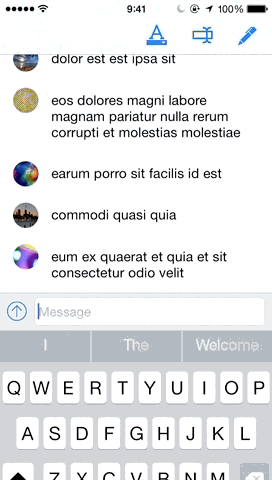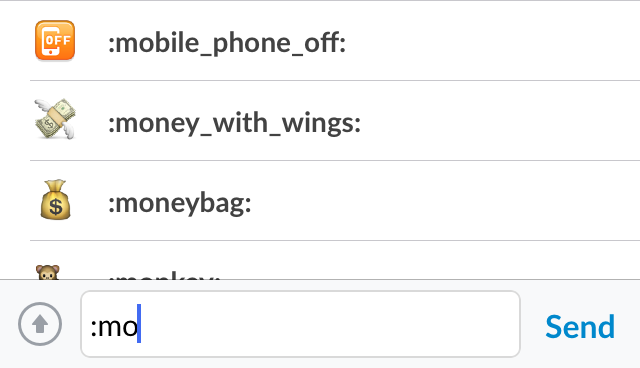#SlackTextViewController
A drop-in UIViewController subclass with a growing text input view and other useful messaging features. Meant to be a replacement for UITableViewController & UICollectionViewController.
This library is used in Slack's iOS app. It was built to fit our needs, but is flexible enough to be reused by others wanting to build great messaging apps for iOS.
- Works out of the box with UITableView or UICollectionView
- Growing text view, with line count limit support
- Customizable: provides left and right button, and toolbar outlets
- Tap gesture for dismissing the keyboard
- Pan gesture for sliding down the keyboard
- Flexible UI built with Auto Layout
- Undo/Redo (with keyboard commands and UIMenuController)
- Text appending APIs
- Autocomplete mode by registering any prefix key (
@,#,/) - Edit mode
- Typing indicator display
- Shake gesture for undo
- Multimedia pasting (png, gif, mov, etc.)
- Inverted mode for displaying cells upside-down (using CATransform) -- a necessary hack for some messaging apps (including ours)
- Bouncy animations
- iOS 7 & 8
- iPhone & iPad
- Storyboard
- UIPopOverController & UITabBarController
- Container view controller
- External keyboard commands
- Auto-Rotation
- Localization
Available in Cocoa Pods
pod 'SlackTextViewController'
##How to use
###Subclassing
SLKTextViewController is meant to be subclassed, like you would normally do with UITableViewController or UICollectionViewController. This pattern is a convenient way of extending UIViewController. SlackTextViewController manages a lot behind the scenes while still providing the ability to add custom behaviours. You may override methods, and decide to call super and perform additional logic, or not to call super and override default logic.
Start by creating a new subclass of SLKTextViewController.
In the init overriding method, if you wish to use the UITableView version, call:
[super initWithStyle:UITableViewStylePlain]
or the UICollectionView version:
[super initWithCollectionViewLayout:[UICollectionViewFlowLayout new]]
Protocols like UITableViewDelegate and UITableViewDataSource are already setup for you. You will be able to call whatever delegate and data source methods you need for customising your control.
Calling [super init] will call [super initWithStyle:UITableViewStylePlain] by default.
###Growing Text View
The text view expands automatically when a new line is required, until it reaches its maxNumberOfLinesvalue. You may change this property's value in the textView.
By default, the number of lines is set to best fit each device dimensions:
- iPhone 4 (<=480pts): 4 lines
- iPhone 5/6 (>=568pts): 6 lines
- iPad (>=768pts): 8 lines
On iPhone devices, in landscape orientation, the maximum number of lines is changed to fit the available space.
###Autocompletion
We use autocompletion for many things: names, channels, emoji, and more.
To set up autocompletion in your app, follow these simple steps:
You must first register all the prefixes you'd like to support for autocompletion detection:
[self registerPrefixesForAutoCompletion:@[@"#"]];
Every time a new character is inserted in the text view, the nearest word to the caret will be processed and verified if it contains any of the registered prefixes.
Once the prefix has been detected, -canShowAutoCompletion will be called. This is the perfect place to populate your data source, and return a BOOL if the autocompletion view should actually be shown. So you must override it in your subclass, to be able to perform additional tasks. Default returns NO.
- (BOOL)canShowAutoCompletion
{
NSString *prefix = self.foundPrefix;
NSString *word = self.foundWord;
self.searchResult = [[NSArray alloc] initWithArray:self.channels];
if ([prefix isEqualToString:@"#"])
{
if (word.length > 0) {
self.searchResult = [self.searchResult filteredArrayUsingPredicate:[NSPredicate predicateWithFormat:@"self BEGINSWITH[c] %@ AND self !=[c] %@", word, word]];
}
}
if (self.searchResult.count > 0) {
self.searchResult = [self.searchResult sortedArrayUsingSelector:@selector(localizedCaseInsensitiveCompare:)];
}
return self.searchResult.count > 0;
}
The autocompletion view is a UITableView instance, so you will need to use UITableViewDataSource to populate its cells. You have complete freedom for customizing the cells.
You don't need to call -reloadData yourself, since it will be called automatically if you return YES in -canShowAutoCompletion method.
The maximum height of the autocompletion view is set to 140 pts by default. You can update this value anytime, so the view automatically adjusts based on the amount of displayed cells.
- (CGFloat)heightForAutoCompletionView
{
CGFloat cellHeight = 34.0;
return cellHeight*self.searchResult.count;
}
If the user selects any autocompletion view cell on -tableView:didSelectRowAtIndexPath:, you must call -acceptAutoCompletionWithString: to commit autocompletion. That method expects a string matching the selected item, that you would like to be inserted in the text view.
- (void)tableView:(UITableView *)tableView didSelectRowAtIndexPath:(NSIndexPath *)indexPath
{
if ([tableView isEqual:self.autoCompletionView]) {
NSString *item = self.searchResult[indexPath.row];
[self acceptAutoCompletionWithString:item];
}
}
````
The autocompletion view will automatically be dismissed and the chosen string will be inserted in the text view, replacing the detected prefix and word.
You can always call `-cancelAutoCompletion` to exit the autocompletion mode and refresh the UI.
###Edit Mode

To enable edit mode, you simply need to call `[self editText:@"hello"];`, and the text input will switch to edit mode, removing both left and right buttons, extending the input bar a bit higher with "Accept" and "Cancel" buttons. Both of this buttons are accessible in the `SLKTextInputbar` instance for customisation.
To capture the "Accept" or "Cancel" events, you must override the following methods.
````
- (void)didCommitTextEditing:(id)sender
{
NSString *message = [self.textView.text copy];
[self.messages removeObjectAtIndex:0];
[self.messages insertObject:message atIndex:0];
[self.tableView reloadData];
[super didCommitTextEditing:sender];
}
- (void)didCancelTextEditing:(id)sender
{
[super didCancelTextEditing:sender];
}
````
Notice that you must call `super` at some point, so the text input exits the edit mode, re-adjusting the layout and clearing the text view.
Use the `editing` property to know if the editing mode is on.
###Typing Indicator

Optionally, you can enable a simple typing indicator, which will be displayed right above the text input. It shows the name of the people that are typing, and if more than 2, it will display "Several are typing" message.
To enable the typing indicator, just call `[self.typeIndicatorView insertUsername:@"John"];` and the view will automatically be animated on top of the text input. After a default interval of 6 seconds, if the same name hasn't been assigned once more, the view will be dismissed with animation.
You can remove names from the list by calling `[self.typeIndicatorView removeUsername:@"John"];`
You can also dismiss it by calling `[self.typeIndicatorView dismissIndicator];`
###Panning Gesture
Dismissing the keyboard with a panning gesture is enabled by default with the `keyboardPanningEnabled` property. You can always disable it if you'd like.
###Shake Gesture

A shake gesture to clear text is enabled by default with the `undoShakingEnabled` property.
You can optionally override `-willRequestUndo`, to implement your UI to ask the users if he would like to clean the text view's text. If there is not text entered, the method will not be called.
If you don't override `-willRequestUndo` and `undoShakingEnabled` is set to `YES`, a system UIAlertView will prompt.
###Inverted Mode
Some UITableView layouts may require that new messages enter from bottom to top. To enable this, you must use the `inverted` flag property. This will actually invert the UITableView or UICollectionView, so you will need to do a transform adjustment in your UITableViewDataSource method `-tableView:cellForRowAtIndexPath:` for the cells to show correctly.
````
- (UITableViewCell *)tableView:(UITableView *)tableView cellForRowAtIndexPath:(NSIndexPath *)indexPath
{
UITableViewCell *cell = [self.tableView dequeueReusableCellWithIdentifier:chatCellIdentifier];
// Cells must inherit the table view's transform
// This is very important, since the main table view may be inverted
cell.transform = self.tableView.transform;
}
````
###External Keyboard
There a few basic key commands enabled by default:
- cmd + z -> undo
- shift + cmd + z -> redo
- return key -> calls `-didPressRightButton:`, or `-didCommitTextEditing:` if in edit mode
- shift/cmd + return key -> line break
- escape key -> exits edit mode, or auto-completion mode, or dismisses the keyboard
- up & down arrows -> vertical cursor movement
To add additional key commands, simply override `-keyCommands` and append `super`'s array.
-
(NSArray *)keyCommands { NSMutableArray *commands = [NSMutableArray arrayWithArray:[super keyCommands]];
// Edit last message [commands addObject:[UIKeyCommand keyCommandWithInput:UIKeyInputUpArrow modifierFlags:0 action:@selector(editLastMessage:)]];
return commands; }
##Storyboard
When using SlackTextViewController with storyboards, instead of overriding the traditional `initWithCoder:` you will need to override any of the two custom methods below. This approach helps preserving the exact same features from the programatic approach, but also limits the edition of the nib of your `SLKTextViewController` subclass since it doesn't layout subviews from the nib (subviews are still initialized and layed out programatically).
if you wish to use the `UITableView` version, call:
```
+ (UITableViewStyle)tableViewStyleForCoder:(NSCoder *)decoder
{
return UITableViewStylePlain;
}
```
or the `UICollectionView` version:
```
+ (UICollectionViewLayout *)collectionViewLayoutForCoder:(NSCoder *)decoder
{
return [UICollectionViewFlowLayout new];
}
```
##Sample Project
Check out the sample project, everything is demo'd there.
There are 2 main examples (different targets) for testing the programatic and storyboard approaches.
A CollectionView example, using Swift, is in progress on the `swift-example` branch. The idea with this project is to build a custom collection view layout allowing to display cells from the bottom (currently working but needs serious tweaks to make it perfect).
Feel free to contribute!
##XCode Templates

We have prepared a set of useful XCode templates so you can quickly start using SlackTextViewController.
To install them, open up your terminal and type:
```sh ./SlackTextViewController/File\ Templates/install.sh```
These templates are also available in [Alcatraz](https://github.com/supermarin/Alcatraz).




